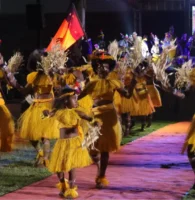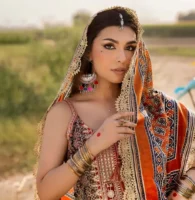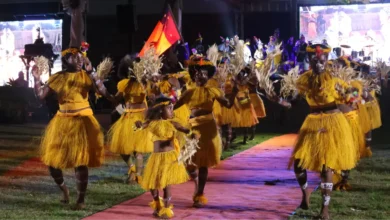The Huli Wig: A Masterpiece of Tradition and Identity
Discover the stunning Huli Wigmen tribal costume of Papua New Guinea — from handcrafted wigs and ochre body paint to ceremonial adornments. Explore the cultural meaning, history, and global fascination behind this iconic Melanesian tradition.
Who Are the Huli Wigmen?
The Huli Wigmen are one of Papua New Guinea’s most visually arresting and culturally rich indigenous groups. Hailing from the Hela Province in the Southern Highlands, the Huli people are globally renowned for their elaborate ceremonial costumes — especially their iconic handcrafted wigs, vibrant body paint, and symbolic adornments.
More than just aesthetic spectacle, the Huli Wigmen’s costume is a deeply spiritual and social expression — marking rites of passage, clan identity, warrior status, and ancestral reverence. Today, their image is celebrated in documentaries, travel photography, and cultural exhibitions worldwide.
The Huli Wig: A Masterpiece of Tradition and Identity

🎩 What Is the Huli Wig?
Known locally as “Bena Huli”, the wig is the centerpiece of the Huli Wigmen’s costume. Unlike wigs made from synthetic or animal hair, each Huli wig is crafted from the wearer’s own hair — grown, shaped, and styled over many months.
See also Traditional Attires from New Ireland Province, Papua New Guinea
Traditional Attires from New Ireland Province, Papua New Guinea🧵 How Is the Wig Made?
- Hair Cultivation: Young Huli men grow their hair for 12–18 months, avoiding cuts or styling.
- Shaping: Hair is cut and molded over a bamboo frame into a large, rounded dome or crescent shape.
- Decoration: Wigs are adorned with:
- Birds of Paradise feathers (symbolizing beauty and status)
- Cassowary quills
- Cuscus fur
- Flowers and orchids
- Ochre dyes (red, yellow, white)
🎭 Cultural Significance
- Rite of Passage: Receiving and wearing the wig marks the transition to manhood.
- Social Status: More elaborate wigs indicate higher rank, wealth, or achievements in battle or hunting.
- Ceremonial Use: Worn during Sing-Sings (tribal gatherings), initiations, funerals, and peace ceremonies.
💡 Did You Know? Huli men often own multiple wigs — one for daily wear, and more ornate versions reserved for rituals or warfare.
Body Paint & Facial Decoration: The Canvas of the Warrior

The Huli Wigmen’s costume isn’t complete without their striking body art.
🎨 Colors and Materials
- Red Ochre (from clay): Symbolizes strength, earth, and bloodline.
- White Lime/Chalk: Represents ancestral spirits and purity.
- Yellow Clay: Associated with fertility and celebration.
- Charcoal Black: Used for contrast and intimidation.
✍️ Patterns and Symbolism
Geometric lines, swirls, and dots are painted across the face, chest, and limbs. These designs often:
- Identify clan affiliation
- Offer spiritual protection
- Celebrate hunting or battle victories
- Intimidate rivals or enemies
Facial markings around the eyes — resembling “war paint” — are particularly dramatic, designed to channel ancestral power and strike fear.
See also Sindhi Ajrak and Topi: The Timeless Symbols of Sindh’s Heritage
Sindhi Ajrak and Topi: The Timeless Symbols of Sindh’s HeritageTraditional Attire & Accessories

Beyond the wig and paint, the full Huli Wigmen costume includes:
🩳 Grass Skirts & Bark Belts
- Worn around the waist, made from forest fibers, orchid stems, or bark cloth.
- Sometimes paired with a koteka (penis gourd), though less common than in neighboring tribes like the Dani.
💍 Arm & Leg Bands
- Crafted from fur, shells, vines, or woven fibers.
- Indicate status, bravery, or marital standing.
🐗 Necklaces & Shell Money
- Strung with boar tusks, shells, seeds, or teeth.
- Historically used as currency and dowry items.
- Boar tusk necklaces, in particular, symbolize hunting prowess.
Ceremonial Context: When and Why the Costume Is Worn
The Huli Wigmen don’t wear their full regalia daily. The costume is reserved for:
- Sing-Sing Festivals — large intertribal gatherings with dance, music, and costume competitions.
- Initiation Ceremonies — marking a boy’s passage into manhood.
- Peace-Making Rituals — resolving clan disputes through symbolic performance.
- Funerals & Ancestral Rites — honoring the dead and invoking spiritual guidance.
These events are not performances for tourists — they are deeply sacred traditions that maintain social cohesion and cultural continuity.
Global Fascination & Cultural Preservation
The Huli Wigmen have become global cultural icons, featured in:
- National Geographic documentaries
- Travel photography exhibitions
- Ethnographic museums (e.g., British Museum, Smithsonian)
- Tourism campaigns for Papua New Guinea
However, with modernization and missionary influence, some traditions have faded. Thankfully, cultural revival efforts are underway — supported by local leaders, NGOs, and the Papua New Guinea government — to preserve Huli customs for future generations.
🌍 Travel Tip: If visiting PNG, attend the Mount Hagen Cultural Show or Goroka Show to witness Huli Wigmen in full ceremonial regalia — respectfully and ethically.
FAQs About the Huli Wigmen Costume
❓ Why do Huli men wear wigs?
To signify manhood, social status, and ceremonial readiness. The wig is a cultural badge of honor.
❓ Are the wigs made from real hair?
Yes — each wig is made from the wearer’s own hair, grown over 1–1.5 years.
❓ What do the body paints mean?
Colors and patterns represent clan identity, spiritual beliefs, achievements, and ritual purposes.
❓ Can tourists buy or wear Huli wigs?
Authentic wigs are not for sale — they are personal and sacred. However, souvenir replicas may be available in cultural markets.
Conclusion: More Than a Costume — A Living Legacy
The Huli Wigmen tribal costume is not merely a visual spectacle — it is a living cultural archive. Every feather, every brushstroke of ochre, every woven band tells a story of ancestry, bravery, and community.
As one of the most recognizable symbols of Papua New Guinea’s cultural diversity, the Huli Wigmen remind us that tradition, when honored and preserved, continues to thrive — even in our modern world.


